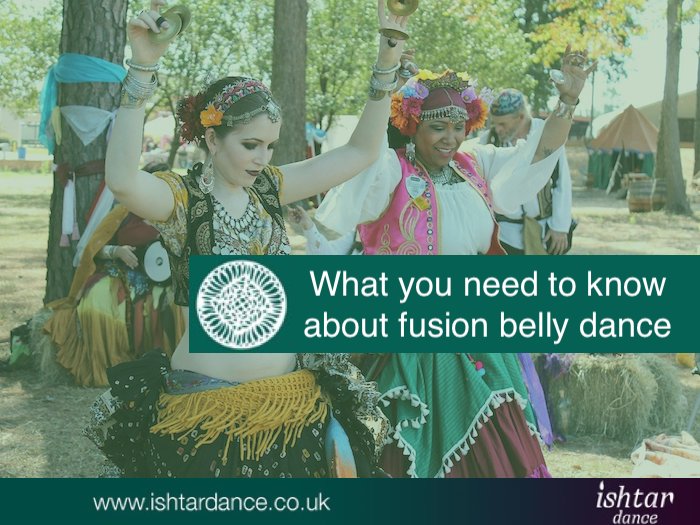Introduction to fusion dance
By Ishtar Dance on Thursday, June, 4th, 2020 in Dance Coaching, Dance Inspiration, Learning 1 Comment

Fusion music and dance isn’t a new concept. Egyptian star dancer Samia Gamal was heavily influenced by Russian ballet and composer Mohammed Abdul Wahab experimented with western rhythms and orchestrations. But it’s not only the West influencing the East – the exchange has also gone the other way with Shakira dancing to Um Kalthoum and musicians like Sting and Snoop Dogg collaborating with Egyptian artists.
The term ‘fusion’ is used to cover many different aspects of dance and I for one consider myself a fusion dancer as I love to mix my knowledge and experience of Ballroom, Latin, Jazz Bollywood and Flamenco with belly dance technique. But many people do in fact mean ‘tribal fusion’ when they talk about ‘fusion’, so here is a quick overview of what the different names and terminology mean.
Salimpour, ATS and other fusion
Fusion dance as we refer to it today originated the US. Jamila Salimpour, famous for her Salimpour format of teaching, was a night club dancer for many years, but changed her style to become more earthy when she went into teaching. American Tribal Style [ATS] was started as a reaction against the popular cabaret style of belly dance, and is also very earthy, mainly inspired by indian dance and North African tribes like the Ouled Nail. You can view the short video below from the Salimpour School of Dance to get a feel for how ‘tribal’ was invented.
You may also have heard of Fat Chance Belly Dance and Gypsy Caravan, which all have slightly different formats but also are very closely linked, despite being different school of belly dance.
Tribal Fusion
The term Tribal Fusion covers a slightly different dance style even if the dance vocabulary often is very similar, yet performed differently. The music used can vary from world fusion to traditional Eastern European. Dancers will try to find music that no one else has danced to before, so tracks are often edited using various sources to make up a unique and interesting performance.
If you are interested in learning more about the history, music and culture behind Tribal Fusion as well as traditional Belly Dance, then I recommend you check out the JWAAD Music Course, which covers all of this in much more depth. Specialist teachers including Hilde Cannoodt and Charlotte Wassell have contributed and taught on the course, which also includes workshops in Tribal Fusion dance. Find out more here.
Interestingly many Tribal Fusion dancers now only use the term ‘fusion’ to describe their style and in the last 5 years there seems to have been a big shift in what is considered tribal, fusion and tribal fusion.
There are of course many other types of fusion dance out there and everything from the popular Latin styles to more specialised Vogueing or Wacking has been fused in belly dance routines. As a former Latin and Ballroom dancer I love fusing different styles but it’s always important to remember a few golden rules.
Things to remember before you start fusing
Always know you stuff. That goes for technique, step patterns, costuming etc. If you want to fuse Tango and Belly Dance you should really be an accomplished dancer in both styles first, and that includes taking classes and working on your technique for both.
Once you know the rules you can break them. If for example you want to do a Rumba Belly Dance fusion [which makes sense as the Rumba rhythm often is used in Egyptian dance] you will know that you don’t need to stick to the same timings and movement patterns as in the traditional Rumba. But you can do – and you can mix it up with a more traditional Egyptian approach to the rhythm too. Check out my blog post on Rumba fusion and technique here.
Know your music. It may be obvious but so often this is a part that gets missed and can cause a lot of controversy. You don’t want to do a cheeky Latin Belly Dance fusion to a song about death or religion! It can be okay to use music that wasn’t composed for the purpose of your dance [the fusion of styles] but do make sure you do your research first in order not to offend anyone.
The word fusion can’t just replace lack of knowledge. Meaning, make sure you check of the first three points made. If you are really not sure, then ask someone that may know or can help you. We can’t all know everything and as dancers we should never stop learning. The same goes if someone asks you a question that you don’t know the answer to. Simply reply: great question, I don’t actually but I’ll be very happy to find out and can then let you know. This will not only give you credit in the eyes of the person asking the question, but you are also maintaining your integrity and will learn something new in the process.
And now ‘just dance’!
As said at the beginning, fusion is a very old and also nearly unavoidable thing in dance and music. At the end of the day we want to be able to express ourselves and have fun dancing as well as share our passion and joy for doing so. So once you’ve done your research it’s time to have fun and just dance.
I am not an expert in Tribal Fusion, but I admire the style and have taken quite a few workshops to get my foundation right, and this term I’m actually teaching some for the first time too. I am really enjoying it and it may even send me down a new path in my dance history – who knows! But bottom line is, I have already told my students that I’m an Egyptian Style Belly Dancer by training, and I will do my best to do the style justice.
Have you ever ventured of your traditional dance path and discovered new interest and fusion styles? Let me know by leaving a comment below so we can keep the knowledge sharing going. Safe, happy and ever evolving dancing everyone.
Dorte
Did you miss my last post? Read it here: How to stay motivated and move better during lockdown

great article that explains what Fusion Dance is and how onna is similar to modern dance